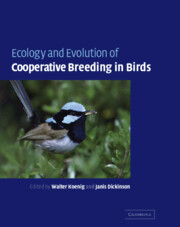Book contents
- Frontmatter
- Contents
- List of contributors
- Introduction
- 1 Evolutionary origins
- 2 Delayed dispersal
- 3 Fitness consequences of helping
- 4 Parental care, load-lightening, and costs
- 5 Mating systems and sexual conflict
- 6 Sex-ratio manipulation
- 7 Physiological ecology
- 8 Endocrinology
- 9 Incest and incest avoidance
- 10 Reproductive skew
- 11 Joint laying systems
- 12 Conservation biology
- 13 Mammals: comparisons and contrasts
- 14 Summary
- Names of bird and mammal species mentioned in the text
- References
- Taxonomic index
- Subject index
4 - Parental care, load-lightening, and costs
Published online by Cambridge University Press: 02 December 2009
- Frontmatter
- Contents
- List of contributors
- Introduction
- 1 Evolutionary origins
- 2 Delayed dispersal
- 3 Fitness consequences of helping
- 4 Parental care, load-lightening, and costs
- 5 Mating systems and sexual conflict
- 6 Sex-ratio manipulation
- 7 Physiological ecology
- 8 Endocrinology
- 9 Incest and incest avoidance
- 10 Reproductive skew
- 11 Joint laying systems
- 12 Conservation biology
- 13 Mammals: comparisons and contrasts
- 14 Summary
- Names of bird and mammal species mentioned in the text
- References
- Taxonomic index
- Subject index
Summary
Helping behavior is enigmatic as it appears to entail an individual sacrificing personal reproduction while assisting others in their breeding attempts. Over the past 40 years, the field of cooperative breeding has developed a rich body of theory to explain helping behavior, and enough cooperative species have been studied in detail to establish common ground and test theory. Indeed Emlen (1997a) stated that the original paradox of cooperative breeding had largely been resolved with the widespread confirmation that (1) helpers are often individuals that are constrained from breeding due to a shortage of quality breeding opportunities, (2) helpers unable to obtain breeding positions in the current year frequently improve their chances of becoming breeders in the future, and (3) helpers frequently obtain large indirect benefits by helping to rear collateral kin. With identification of these direct and indirect benefits to helpers, Emlen suggested that the original questions asked by researchers in this field would appear to be “largely answered.”
In contrast, Cockburn (1998) concluded that “we are still some way from understanding the adaptive significance of helping behavior although we are poised for a reinvigoration of the study of cooperation through a number of conceptual, empirical, and technical advances.” Clearly, conceptual breakthroughs have been made, but many important questions also remain unanswered. In particular, our understanding of the varying level of helper contributions within and between species and how these contributions benefit breeders and helpers remains poor.
- Type
- Chapter
- Information
- Ecology and Evolution of Cooperative Breeding in Birds , pp. 67 - 80Publisher: Cambridge University PressPrint publication year: 2004
- 70
- Cited by

